|
The "Lost Tombs" Revisited:
"Success Has a Thousand Fathers ..."
Part II
So, let’s look at this "credit thing" a little closer ...
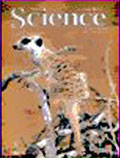 Prior to the World Wide Web, assigning priority to "who discovered
what ... and when" was somewhat easy: the scientist who published
first became the title holder. Where he published (and it was almost
always "he") was also critical -- because an obscure scientific
journal, or a "popular" pioneering article published in a
non-scientific newspaper or magazine, as opposed to "one of the big
five" -- like Science, or Nature-- was just far less likely to be
read by other scientists, and thus a prior discovery announcement
could easily be missed ... Prior to the World Wide Web, assigning priority to "who discovered
what ... and when" was somewhat easy: the scientist who published
first became the title holder. Where he published (and it was almost
always "he") was also critical -- because an obscure scientific
journal, or a "popular" pioneering article published in a
non-scientific newspaper or magazine, as opposed to "one of the big
five" -- like Science, or Nature-- was just far less likely to be
read by other scientists, and thus a prior discovery announcement
could easily be missed ...
And citation of your paper in the papers of other scientists within
your field -- if you thought you had noticed something different
than anybody else, before they noticed it -- was (and is) the key
objective of the well-known "publish or perish" scientific syndrome
in all fields.
The Web has changed all that ... at least, outside the traditional
scientific establishment.
On the Web now, anyone can set-up his or her own "journal" (they’re
called "Home Pages"). And, they can post news (and pictures!) about
any "discovery" they want.
So what?
Going through literally hundreds of thousands of web pages,
searching for a "prior claim" -- as opposed to reading through a
score of well-known, published, monthly journals -- is just
impossible. And, the key to public and scientific acceptance of such
claims lies in independent, institutional verification of the
process. On the Web, dates can easily be changed, and even so-called
"witnesses" ("oh, I saw that on his Website back in 1992 ...") can
easily be bought or manufactured. Remember: on the Web, no one knows
you’re a dog ...
So, how is "priority" (outside of peer-reviewed, scientific journals
) now to be established?
By doing what we did with "Abydos" -- convince some independent,
major, neutral institution to spend the time and money to go and
examine the evidence first-hand. And then, publish the results --
like the March 2nd Special on Fox Television.
Until that actually occurred at Abydos, "the Glyphs" were simply one
more "fantastic claim" spreading like a virus through the World Wide
Web ...
The situation is a little analogous to Einstein’s famed Theory of
General Relativity itself.
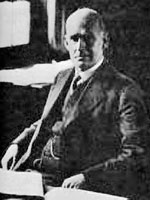 Even after publication in 1915 (in a recognized scientific journal),
no one wanted to believe an obscure Swiss patent clerk’s "peculiar"
Theory of Time flowing at very different rates within the same
Universe, depending on whether or not you were standing still! It
was a relatively unknown British astronomer, Arthur Stanley Eddington (left), in leading an entire "eclipse expedition" to South
America in 1919, who first put Einstein "on the map." Even after publication in 1915 (in a recognized scientific journal),
no one wanted to believe an obscure Swiss patent clerk’s "peculiar"
Theory of Time flowing at very different rates within the same
Universe, depending on whether or not you were standing still! It
was a relatively unknown British astronomer, Arthur Stanley Eddington (left), in leading an entire "eclipse expedition" to South
America in 1919, who first put Einstein "on the map."
Eddington’s subsequent announcement before England’s prestigious
Royal Society, of the successful photographic verification of one of
Einstein’s key predictions -- the tiny gravitational deflection of
starlight as it passes by the Sun (below right) -- became the first
apparent confirmation of the far-out Theory.
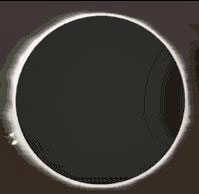 Both the scientific community and the world at large, until that
happened, had simply ignored Einstein’s revolutionary concepts;
after Eddington’s astronomical success ... both men instantly became
world famous: the "discoverer" ... and ... the scientist who
announced that he had verified a major aspect of the Einstein Theory
... Both the scientific community and the world at large, until that
happened, had simply ignored Einstein’s revolutionary concepts;
after Eddington’s astronomical success ... both men instantly became
world famous: the "discoverer" ... and ... the scientist who
announced that he had verified a major aspect of the Einstein Theory
...
Based on the fame achieved with this accomplishment alone, Sir
Arthur Eddington went on to become essentially "the Carl Sagan" of
the early 20th Century, writing (among other things) scores of
astronomical "best-sellers." He ultimately even got a Knighthood for
his efforts (something even Einstein never got!) ...
Only now, literally decades later, has the scientific community
begun to seriously question whether
Eddington could technically have
achieved the results he claimed he got; in terms of Eddington’s
example, then, as with Pierre Salinger’s before, I didn’t wish our
own attempted verification of the controversial "Glyphs at Abydos"
to follow the same plot ...
One of the first things I discovered in my continuing Abydos
research was that, in terms of the Egyptological community itself,
the so-called "Abydos Glyphs" had only been a topic of discussion
(and then, only briefly -- see below!) since early 1998 -- only a
few months before I got hold of them. They apparently had been
e-mailed (like mine) to an on-going, professional Egyptology
discussion group -- the "Osiris List" --
Which instantly dismissed them.
I determined this by eventually finding a
French archaeological site
devoted to the topic. There on the site were reproduced three
different images of the controversial glyphs -- two "wide-angle"
(one obviously "frame-grabbed" from a video -- see below), which
were attributed; the other was the same anonymous "close-up" I’d
received!
Note the caustic comments:
" ... this very same picture was discussed on the "Osiris List" just
a few months ago. I assume you know of the list? Its address is: osirisl@idirect.ca. Please write to the list and ask that somebody
point you to this topic. I am sure that scholars on that list will
be able to aid you better than I can.
"Sincerely,
Professor M. A. R. Barker."
Or, the following -- primarily in French, though the English part is
very clear indeed:
"Le premier mail reçu fut celui de Peter Manuelian, du
’Museum of
Fine Arts’ de Boston : ’What you are looking at is nonsense;
hieroglyphs that have been digitally altered by someone.’ Réponse
laconique. Ce monsieur ne connaissait apparemment pas le problème...
Toutefois, il est vrai que la photo la plus souvent diffusée (voir
bandeau) a été retouchée mais pas es autres. Mais on peut comprendre
le ton de Peter Der Manuelian ..."
And this:
click to enlarge

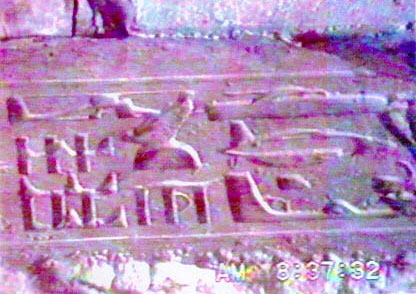
"If you take a look at the second image [lower], that gives the
context of the "mystery text", you will notice that the text is
written in sunken relief (signs are carved in the stone). If you
compare that to the first image (the detail -- [upper]), you will
see that it is in raised relief (signs are lying on the stone). In
the first image [upper], the stone looks more like copper or bronze
then like stone. Compare in the first image the sign that looks like
a helicopter to the corresponding sign in the second image. You will
see that they are not completely the same.
The sign in the second
image shows three hills and doesn’t look like a helicopter. The
three sets of three strokes in the second image are not entirely
alike to the first image either. The second image allows us to
identify the text as part of the titulary of Ramesses II and can be
translated as "The one of the Two Ladies, who surpresses the nine
foreign countries". Conclusion: the first image has been tampered
with. It is a hoax, a fake, a fraude. The person who created this
fake didn’t even take the time to cover his tracks and left some
very obvious traces of his ’work.’"
Kind regards,
Jacques Kinnaer
http://www.ancient-egypt.org/
This conclusion -- that one of
the Abydos images somehow had been
"altered" -- not only fit perfectly with my own initial instincts,
it was "the thing" that I’d subliminally noticed March 2nd,
regarding the Fox crew’s video inside the Temple compared to the
anonymous graphic I’d received several months before ... they were
subtly different!
So: someone had digitally "retouched" the close-up of the glyphs.
The question now was: whom!? And ... for what reason?
My now-intensifying search for Abydos-related "Webstuff" soon led me
to
another Website, sponsored by a radio competitor of Art’s -- talk
show host, Jeff Rense. Under the title, "Hoagland’s Abydos Photos?
NO...They Are Mine and Ruth Hover’s, an individual named Richard Motzer had posted on March 9th -- three days after my heart attack
(when I was clearly in no condition to respond!) -- another in the
sudden "cottage industry" of fevered accusations against me over
"Abydos" and "Fox." This one stated:
" The pictures on
Richard Hoagland’s ’Enterprise Mission’ website of
ABYDOS are Ruth & Harry Hover’s ... not Richard Hoagland’s. The
clear one is my own graphic clean-up of the Hover’s second photo
..."
Now, this was interesting ... not only because I never claimed
ownership of the mysterious, anonymous images of Abydos ... but
because Motzer went on to "explain" how he himself had screwed up
the "clean up" of the close-up photo (!), ostensibly taken by "the
Hovers." According to Motzer’s March 9th posting on
Jeff Rense’s
Website,
"... The Hovers took two photos at ABYDOS, one of which shows the
ceiling and pillars, plus the panel. It has good focus, and
exposure, but is taken some distance back.
"The second picture is a close-up with good focus & exposure but she
moved the camera up and to the right, causing a ghost-like shadow.
They asked me if I could remove this flaw, and I said I could, using
the good picture as a reference.
"Now, the next part is very inportant [sic]. I made several mistakes
by removing icons from this photo. It was a judgment call on my
part, and the ABYDOS site caught this right away. They thought I had
created a HOAX but that was certainly not the case... it was just an
’over clean-up’ of a legitimate photo ... "
Now let me get this straight: Some friends of yours go all the way to Egypt, find a set of
carvings in an ancient Temple which look stunningly like
"helicopters" and other completely off-the-wall "high-tech" ancient
Egyptian "stuff" ... and they only take two photos of these amazing
graphics; one of which (the crucial close-up), somehow turns out
"smeared" when they get back?
So you, Richard Motzer -- proclaiming yourself a "computer imaging
expert" -- in attempting to restore details of the original, leave
such heavy-handed "digital fingerprints" all over your attempt ...
that everyone who subsequently sees it immediately dismisses it
outright as "just another hoax!"
"... Conclusion:
the first image has been tampered with. It is a
hoax, a fake, a fraude. The person who created this fake didn’t even
take the time to cover his tracks and left some very obvious traces
of his ’work’..."
Question: given the obvious importance of an unsmeared image, and
(considering the subject matter!) one that wouldn’t be so easily
dismissed -- why, for God’s sake (if, for nothing else, than to
protect your reputation ...), didn’t you try again ... until you got
it right!
The next part of Motzer’s strange "confession/accusation" seems to
hold the answer to this crucial question:
" ... A well-known UFO researcher posted these photos on the
internet without permisson [sic] from either of us quite some time
ago. We had forgoten [sic] this until the FOX special. After the
show, I went to Richard Hoagland’s ’Enterprise Mission’ website and
I was stunned to find our picture there.
" Mr. Hoagland has been caught in a big one this time ..."
No, sir, I’m afraid you have ...
Because, the answer to my original question lies in those two lines
...
"... A well-known UFO researcher posted these photos on the internet
without permisson [sic] from either of us quite some time ago. We
had forgoten [sic] this until the FOX special ..."
We are to believe, from
Richard Motzer’s posting on Jeff Rense, that
the sole reason he has "gone public" over this is because he was
"stunned" at a fundamental miscarriage of justice carried on the
"Enterprise Mission" Website: I have stolen "credit" for his work
(and by inference, the "Hover" photographs as well).
Yet, we are also told in these two lines that another individual, a
"well-known UFO researcher ..." did essentially the same thing to
him and to "the Hovers" ... yet, this "low life" is never named for
his "transgressions!"
And then there is the matter of the "French Connection."
As noted earlier, in searching for evidence of previous discussions
of the Abydos Glyphs, I came across the
French archaeological site
filled with very "illuminating" information. At the top, blatantly
in evidence, is "Motzer’s altered close-up" (now, by his own
admission).
Though I looked hard (and don’t read French -- below), I
could find nowhere on the site an attribution of the graphic -- the
central aspect of the author’s site in France. Thus, I can only
conclude one of two things: a) he "stole" it, or b) it came to him
as it had come to me ... anonymously ... without an attribution.
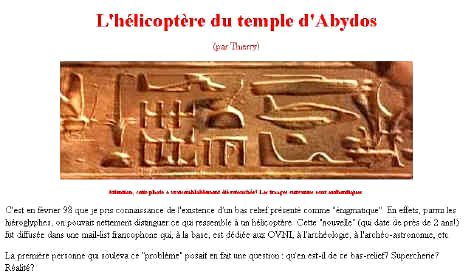
But ... where was Motzer’s righteous anger at this author? Where
were the libelous accusations of "outright theft" against this
Website?
What is this: some kind of "Motzer double standard" when it comes to
"stealing" altered glyphs from Abydos?
Then, there is the matter of "importance."
In my opinion, the obvious reason Motzer botched his clean-up job on
photo # two, and never bothered to "correct" it ... or, the fatal
impressions it inevitably created for this entire issue as a "hoax,"
was because the issue of "authenticity" was apparently never of
critical importance to Motzer in the first place ... or, equally,
"the Hovers!"
If I had taken such extraordinary photos, six thousand miles away in
Egypt, and then someone "blew it" on the so-called "clean-up," I’d
scream bloody murder ... until they got it right. I certainly
wouldn’t continue to allow my photos to be spread around the world
on various
Egyptological Websites, giving the obvious impression
(judging from the highly negative reactions ...) that I’d created
(or was willingly participating in) a major hoax!!
And I certainly wouldn’t "forget" about the entire incident -- the
original unlawful postings on the Internet ... the global
accusations of a major fraud ... the "trashing" of a discovery I
thought of fundamental significance, in my own photographs ... until
reminded (ostensibly) years later ... by a television show.
So what are we to think? Were the "Hovers" the true "discoverers"
of
the Abydos glyphs? Did they fully recognize when they took the
photographs (but, only two!!) the potential, extraordinary nature of
what they were looking at in the ceiling, there in Egypt?
Or, is their (and Richard Motzer’s) new awareness of the possible
"importance" of these photographs, and of "the Glyphs,’" a
relatively recent "insight" -- triggered by my and Debra Gussin’s
strenuous efforts at on-site verification ... and on a major
television network ..?
"Success has a thousand fathers ..."
Judging by the "Hovers" long-term, cavalier actions on the
non-trivial matter of the "imaging enhancements" applied by
Motzer
to those photographs, as well as the apparent lack of any written
protests from "the Hovers" in the face of continued worldwide
accusations of a major "hoax" (let alone their new claim of "lapsed
memories" of the entire matter), obviously--
Not!
Like so much else in the UFO/ET/Internet community, it seems the
claim alone -- and the fleeting "recognition" that goes with it --
was (and still appears to be) the ultimate "reward," not the search
for "what" is truly recorded in the ceiling there at Abydos ...
One final question: the small matter of the "proof":
Why didn’t Mr. Motzer post his originals of the alleged
"Hover/Motzer Abydos photos" with his "Hoagland accusations" on the
"Sightings" Website -- to truly prove his claim? Or, if that was
technically infeasible, send hard copies of the original images to
Rense himself?
Or -- is this the major hole in Motzer’s entire, rambling allegation
..?
That he can’t -- because then it would be revealed that Mr. Motzer
could easily lay hands on images he allegedly had "totally
forgotten" years before ... because -
Motzer could be the guy who -- anonymously -- recently sent his own
"doctored" version of the glyphs to me (and to the other Websites)
in the first place ...
The distinct possibility that this was a "sting" operation all
along, suddenly leaped out.
Who was "Richard Motzer," anyway?
Years ago, Motzer had written me inquiring about "the Mars Project"
(the long-defunct name for our initial Cydonia Investigation).
Later, someone handed me a business card from Motzer -- who had
printed them up without asking and without my knowledge, appointing
himself head of the "Phoenix Mars Project" ... all without
permission.
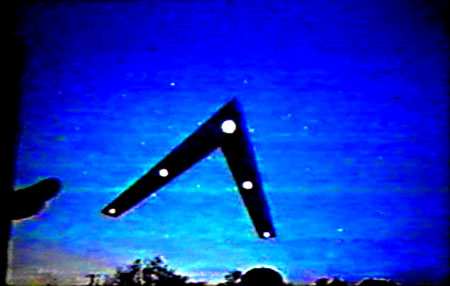
Later, Motzer became a "UFO investigator" -- attached to MUFON (the
Mutual UFO Network) in the Phoenix area. During the controversy that
erupted over the March,1997 "Phoenix Lights Affair,"
Motzer had
publicly resurfaced: loudly proclaiming that the "Lights" were
"flares" -- despite overwhelming eyewitness testimony regarding an
immense, triangular "craft" seen moving slowly over the Phoenix area
that night (see artists’ rendering -- above); and systematic
experiments carried out by other UFO investigators and military
experts, excluding "military flares."
Curiously, for someone supposedly interested in unearthing bonafide
evidence on "ETs" and "UFOs," Motzer’s positions on a variety of
sightings in the Phoenix area over the years haven’t seemed that
different from classic "debunkers" in the field -- like Kal Korff
(with whom Motzer is associated). Raising the suspicion among some
... that he might be some kind of "double agent."
Now, at a crucial time -- but without offering a shred of actual
proof of his involvement -- Motzer was suddenly putting himself
squarely in the middle of the continuing controversy over the
"Glyphs at Abydos."
So ... what better way to derail any and all public interest in "the
Glyphs," than to pass around the Internet images so easily (too
easily!) dismissible as "fakes?" It had apparently worked with
Whitely Strieber’s initial posting of the images:
Whitely ultimately
denounced them as "a hoax." And, judging by the professional
reactions quoted earlier, it worked on several of the Egypt sites as
well. And--
Apparently, not even once, did Richard Motzer (or "the Hovers")
officially protest this reaction as "unfair"...
If not -- why not?
The conclusion seems almost unavoidable: because they ("the Hovers")
ultimately didn’t think it that important; and Richard Motzer ... he
had other plans ...
All derailed, of course, with the sudden surge of renewed interest
in the "glyphs at Abydos" -- after their dramatic, startling
reappearance on a world-wide television show ... followed by my
appearance on Art Bell ... and simultaneous comparisons with
well-known "high-tech" objects presented on "Enterprise" itself.
Of the few Egyptologists who had actually seen the glyphs within the
Temple (and thus, already knew of their reality -- long before I
did), there was a similar -- though more "sophisticated" -- negative
response.
The only problem ... it reminded me, when I finally got to read it,
of a lot of NASA’s initial, equally negative reactions to "the
Face!"
"Quelques instants plus tard, c’était au tour de Mike Dyall-Smith de
l’Université de Melbourne : "We dealt with this on the AEL
discussion list over a year ago. There is a much more mundane
explanation (that is historically interesting in itself). These
pictures have gained some notoriety because they have been promoted
by "new-age or ufo buffs ".
Egyptologists easily
recognize that the
apparent strange craft are just illusions produced by:
"a) erosion of the stone surface (look at the damage over that roof
area!)
"b) a process of re-carving and filling in the stone to replace some
of the hieroglyphs. When the filling falls out bits of the old and
new glyphs overlap and form ’strange signs’. The technical term used
is ’palimpsest’.
Anyone well versed in egyptological inscriptions would tell you
lots of recarving of inscriptions went on in ancient Egypt as ruling
kings sought to acquire the work of previous pharaohs, or to
discredit them.
"Regards,
Mike Dyall-Smith"
And,
":.. I am afraid that you have been subjected to the famous "Abydos
helicopter" mania, here. There is a simple explanation to what you
are seeing, at least, as we see it in Egyptology. There is no
mystery here; it’s just a _palimpsest_ (though without the use of
that term, and which is defined as "... A manuscript, typically of
papyrus or parchment, that has been written on more than once, with
the earlier writing incompletely erased and often legible" AHED). It
was decided in antiquity to replace the five-fold royal titulary of Seti I with that of his son and successor,
Ramesses II.
In the
photos, we clearly see "Who repulses the Nine Bows," which figures
in some of the Two-Ladies names of Seti I, replaced by "Who protects
Egypt and overthrows the foreign countries," a Two-Ladies name of
Ramesses II. With some of the plaster that once covered Seti I’s
titulary now fallen away, certain of the superimposed signs do
indeed look like a submarine, etc., but it’s just a coincidence.
What is happening in the photographs is quite clear; just consult
Juergen von Beckerath, Handbuch der aegyptischen Koenigsnamen,
Muenchner aegyptologische Studien 20, pages 235 and 237. This issue
comes up from time to time on such academic e-mail lists as the
Ancient Near East (ANE) List and so on, so we’re all pretty familiar
with it.
"Regards.
Katherine Griffis-Greenberg
Member, American Research Center in Egypt
International Association of Egyptologists
University of Alabama at Birmingham
Special Studies
"http://www.geocities.com/Eureka/1692/index.html"
And, perhaps the most revealing:
"Dear M. Wathelet,
"Thank you for your letter. My only advice regarding the "strange"
hieroglyphs at Abydos temple is that:
"the Egyptians did not have helicopters, floppy disks or any of the
other ridiculous suggestions -- and if they did, why is Abydos the
ONLY place where they are supposedly represented? NO archaeological
evidence has been found to support the existence of any of these
items in ancient Egypt. This includes evidence of helicopters,
computers, etc. in tomb paintings.
"Moreover, the idiots who wrote that piece do not read Egyptian or
understand the manner in which the language was written.
"The date ascribed to the "temple of Ramses II" in the internet
piece is totally incorrect. Ramses II lived about 1200 BC, not
’5,000 years ago’
"The temple of Ramses II at Abydos is in ruins and not all that much
remains of its inscriptions; the small number of extant inscriptions
includes a list of subject cities in Asia, etc."
Lyn Green
Royal Ontario Museum, Toronto
It appeared, then, that the professional Egyptologists’ cavalier
dismissal of the "Abydos Glyphs" rested on essentially the same
foundation as NASA’s main argument against "Cydonia":
That, since they were "impossible"--
... the Egyptians did not have helicopters, floppy disks or any of
the other ridiculous suggestions ... -- there MUST be a more rational (i.e. "mundane") explanation. And the
"palimpsest" idea -- the well-known Egyptian penchant for filling
old hieroglyphs with plaster, then recarving over the originals with
later hieroglyphs -- seemed the most eminently logical.
But was it true ... in this case?
Notice that not one respondent ever said,
"I went up there on a
ladder ... and physically verified that the plaster of the old
hieroglyphs had fallen out ..." The closest comment was that the
images were the result of -- "... erosion of the stone surface (look at the damage over that roof
area!) ..."
So, what we are left with is essentially the "NASA argument,"
applied to Abydos -- there can’t have ever been intelligent life on
Mars ... so "the Face" must be mere illusion; there can’t have ever
been representations of "high-tech" stuff in Ancient Egypt --
because the Egyptian’s didn’t have any!
Notice that even the language is the same ...
"Egyptologists easily recognize that the apparent strange craft are
just illusions ..."
Yeah -- but did anyone ever physically go up there and check?!
Again ... apparently not.
(Continued in Part III)
|
 Prior to the World Wide Web, assigning priority to "who discovered
what ... and when" was somewhat easy: the scientist who published
first became the title holder. Where he published (and it was almost
always "he") was also critical -- because an obscure scientific
journal, or a "popular" pioneering article published in a
non-scientific newspaper or magazine, as opposed to "one of the big
five" -- like Science, or Nature-- was just far less likely to be
read by other scientists, and thus a prior discovery announcement
could easily be missed ...
Prior to the World Wide Web, assigning priority to "who discovered
what ... and when" was somewhat easy: the scientist who published
first became the title holder. Where he published (and it was almost
always "he") was also critical -- because an obscure scientific
journal, or a "popular" pioneering article published in a
non-scientific newspaper or magazine, as opposed to "one of the big
five" -- like Science, or Nature-- was just far less likely to be
read by other scientists, and thus a prior discovery announcement
could easily be missed ... Even after publication in 1915 (in a recognized scientific journal),
no one wanted to believe an obscure Swiss patent clerk’s "peculiar"
Theory of Time flowing at very different rates within the same
Universe, depending on whether or not you were standing still! It
was a relatively unknown British astronomer, Arthur Stanley Eddington (left), in leading an entire "eclipse expedition" to South
America in 1919, who first put Einstein "on the map."
Even after publication in 1915 (in a recognized scientific journal),
no one wanted to believe an obscure Swiss patent clerk’s "peculiar"
Theory of Time flowing at very different rates within the same
Universe, depending on whether or not you were standing still! It
was a relatively unknown British astronomer, Arthur Stanley Eddington (left), in leading an entire "eclipse expedition" to South
America in 1919, who first put Einstein "on the map." Both the scientific community and the world at large, until that
happened, had simply ignored Einstein’s revolutionary concepts;
after Eddington’s astronomical success ... both men instantly became
world famous: the "discoverer" ... and ... the scientist who
announced that he had verified a major aspect of the Einstein Theory
...
Both the scientific community and the world at large, until that
happened, had simply ignored Einstein’s revolutionary concepts;
after Eddington’s astronomical success ... both men instantly became
world famous: the "discoverer" ... and ... the scientist who
announced that he had verified a major aspect of the Einstein Theory
...


